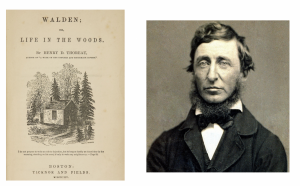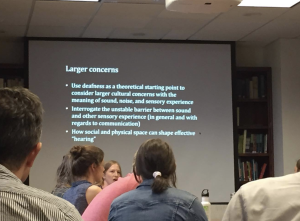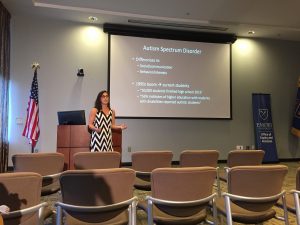“I went to the woods because I wished to live deliberately, to front only the essential facts of life. And see if I could not learn what it had to teach and not, when I came to die, discover that I had not lived.” – Henry David Thoreau
Caption: Closed captions are correct for those with hearing disabilities.

(Perspective of Michael) I leaped off the bus and instantly could smell the fresh pines and soft needles. With each step I gently crushed the leaves and fallen branches below me. The sound of the soil cracking under my shoes urged me to venture out into the trees, but I made sure to remain close. I was only eight years old at the time, but Walden Pond was much more than just a landmark. Just two towns over from my home, it was an escape from reality. The sounds, smells, and sights of nature engulfed my thoughts. I never wanted to leave. Whether it was a deer sipping water with her fawn, or the sounds of the turkeys trotting through the bushes, Walden pond brought wonders beyond imagination for a young boy like me.

Six years later, Michael, Kate, Zion, and Josh found themselves listening to Rachel Kolb, an Emory graduate student, analyzing Thoreau’s work. Kolb, who is partially deaf, explained Thoreau’s opinions on the two different “spheres” of sound that he experienced while living in the wild – natural sound and industrial sound. Thoreau described natural sounds as the things that we hear from the animals and natural parts of life. This connects to all of the sounds that Michael heard at Walden Pond when he was younger. However, industrial sounds come from the new technologies of the time, such as “the noises of the train cars passing by.” Kolb concluded this idea by stating that Thoreau related the noise that he heard to interruptions, which seem to be inevitable aspects of modern day life.

The focus of Kolb’s analysis was on sound, specifically the new technologies of the mid-19th century, which affected people’s ability to enjoy the natural things in life. Kolb described these technologies which, “distract our attention from serious things” as “inventions that collapse the time and distance between two places.” Some of these technologies include railway systems and the telegraph. Kolb argued that these technologies changed the way people perceived space and time, as it was possible to communicate and therefore “listen” to each other while not being in the same location. This phenomenon leads to face-to-face interactions between people having less value. The new technologies of the mid-19th century can be compared to our very own age of social media. The access to information and communication we have from our electronic devices is taking away from our need to talk with each other in person. Both the railways of Thoreau’s period and our modern day digital platforms interrupt our thought and change the way that we interact with each other.

While Rachel was presenting her paper, Michael and Kate noticed the sign language translators that sat on both sides of the table. They connected this to the lecture by Jennifer Sarrett titled “Autism in the Classroom”, which stressed the importance of accommodations for students with learning disabilities. They noticed that Rachel utilized many of the teaching techniques that Sarrett described in her presentation–techniques that help students with learning disabilities better absorb information and that help generalize the presentation to everyone. For instance, Rachel’s whole powerpoint was a black screen with white font. This is a common visual

aid. She also passed out packets of her transcript to the class for those who wanted to read along. It was interesting to witness how a writer with a disability interprets effective teaching. By presenting multiple versions of her presentation, Rachel was really demonstrating the effectiveness of the multimodal communication that she was talking about. Getting to see this perspective really opened our eyes to see how the world spreads ideas in different ways. By utilizing the mode of sound in her presentation despite her deafness being a hindrance, Rachel was emphasizing the strength of sound in formulating thoughts and avoiding distraction.
Whether it was the sound of leaves crunching below Thoreau’s feet or the sight of Rachel’s translators, it is clear that sound plays a variety of roles in our world. Though we never fully realize it, we are constantly adapting to newer ways of communicating through sounds and expressions. Listening to Rachel describe the use of sound in Thoreau’s work was like witnessing the combination of different products. Much like how Walden was forced to adapt to the growing technological influence of his world, Rachel was forced to adapt to her disability and find new ways to analyze everyday senses.
-Josh, Kate, Michael, Zion
Sources:
asl.osu.edu/sites/asl.osu.edu/files/styles/front_short/public/rotor_0.png?itok=WbKtEQVY.
i2.wp.com/www.multipleexperiences.org/wp-content/uploads/2017/04/image-27.jpeg?fit=350%2C292.
media-cdn.tripadvisor.com/media/photo-s/01/06/f7/e2/walden-in-autumn.jpg.
upload.wikimedia.org/wikipedia/commons/thumb/2/25/Walden_Thoreau.jpg/1200px-Walden_Thoreau.jpg.
www.youtube.com/watch?v=b0Quw_RPB0U.
upload.wikimedia.org/wikipedia/commons/thumb/f/f0/Benjamin_D._Maxham_-_Henry_David_Thoreau_-_Restored.jpg/1200px-Benjamin_D._Maxham_-_Henry_David_Thoreau_-_Restored.jpg.
